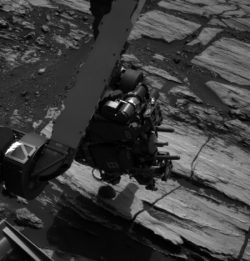A forthcoming congressional report, reported by the Wall Street Journal, reveals that NASA is concerned about cracks that occur in the turbopumps of SpaceX’s Merlin engines.
The newspaper says the report has found a “pattern of problems” with the turbine blades within the turbopumps, which deliver rocket fuel into the combustion chamber of the Merlin rocket engine. Some of the components used in the turbopumps are prone to cracks, the government investigators say, and may require a redesign before NASA allows the Falcon 9 booster to be used for crewed flights. NASA has been briefed on the report’s findings, and the agency’s acting administrator, Robert Lightfoot, told the newspaper that he thinks “we know how to fix them.”
A spokesman for SpaceX, John Taylor, said the company already has a plan in place to fix the potential cracking issue. “We have qualified our engines to be robust to turbine wheel cracks,” Taylor said. “However, we are modifying the design to avoid them altogether. This will be part of the final design iteration on Falcon 9.” This final variant of the Falcon 9 booster, named Block 5, is being designed for optimal safety and easier return for potential reuse. According to company founder Elon Musk, it could fly by the end of this year.
Here’s the real scoop: SpaceX initially built the engines to fly once, just as every single rocket company has done in the entire history of space, excluding the space shuttle. Under these conditions, the cracks could be considered an acceptable issue, which is what they mean when they say “We have qualified our engines to be robust to turbine wheel cracks.” My guess is that they tested the engines, found that the cracks were not a significant problem for a single flight, especially because the Falcon 9 rocket uses nine Merlin engines on the first stage and thus has some redundancy should one fail. And based on SpaceX’s flight record — no launch failures due to failed engines — that conclusion seems reasonable.
SpaceX is now redesigning to eliminate the cracks, however, because such cracks are not acceptable for engines that will fly multiple times on reused first stages.
Thus, this story, as leaked, appears to me to be a hit job by powers in Congress who dislike the competition that SpaceX poses to big government rockets like SLS. SLS will use salvaged shuttle engines, designed initially for many reuses, and thus are superior in this manner to SpaceX’s Merlin engines. The shuttle engines however were also built by the government, which didn’t care very much about the cost of development, or making any profits. The comparison thus is somewhat bogus. Moreover, I suspect these cracks were only discovered after SpaceX successfully landed and recovered some first stages. To put them on trial in the press now for doing good engineering research and redevelopment seems somewhat inappropriate.
The report itself has not yet been released, though it does also note lingering issues with the parachutes being developed for Boeing’s Starliner capsule.
Overall, both companies are struggling to start their operational flights by 2019. For Congress or NASA to try to put more roadblocks up in that development seems most counterproductive.





